#piazza del popolo square
Text
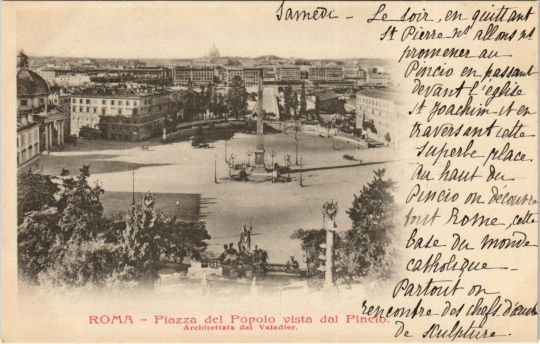
Piazza del Popolo Square in Rome, Italy
Italian vintage postcard
#old#postcard#postkaart#italian#vintage#briefkaart#postal#ansichtskarte#ephemera#photography#photo#piazza del popolo square#italy#postkarte#tarjeta#rome#del#piazza#popolo#square#historic#sepia#carte postale
5 notes
·
View notes
Text

PIAZZA DEL POPOLO - ROMA
81 notes
·
View notes
Text

Santa Maria in Montesanto, Santa Maria dei Miracoli and Flaminio Obelisk, Piazza del Popolo | Rome, Italy, 1662-1679
VS
Giorgio Morandi, Still life, 1958
#giorgio morandi#natura morta#still life#roma#rome#piazza del popolo#square#Santa Maria in Montesanto#Santa Maria dei Miracoli#obelisco#obelisco flaminio#obelisk#carlo rainaldi#carlo fontana#gian lorenzo bernini#architecture#baroque#barocco
25 notes
·
View notes
Text

Piazza del Popolo (People's Square), Roma.
9 notes
·
View notes
Note
OMG thank you I’m just so overwhelmed because there’s so much to see and eat and do in Italy.
Like I can’t even make it to Florence cinque tere or Venice on this trip.
I would loveeeee specific recs for Rome😭
ugh I know I feel like I could live a whole year in Italy and still wouldn't be enough
museums in Rome I recommend:
for Roman/ancient stuff: Trajan's Market, Baths of Diocletian/Caracalla, Palazzo Massimo,
for Modern stuff: Museum of Modern Art and the MAXXI, Palazzo Barberini
just beautiful architecture: Villa Farnesina, Tempietto, Chiostro di Bramante
Churches: Basilica of St. Lateran, Santa Maria Maggiore, San Carlo alle Quattro Fontane, Basilica di Santo Stefano Rotondo
for shopping the area around Piazza del Popolo is really good, but the restaurants there a bit pricier. If you go to St. Peter's and you exit the square along the main road and you keep going straight and cross the piazza there's some really nice restaurants there and this tiramisu place tucked in a corner that is divineeee.
#most of the food recs I have are close to the vatican bc that's where I stayed but it doesn't make sense for you to trek across town for it#u know#like there's good food everywhere really
1 note
·
View note
Note
Hi Lavi! I’ve just arrived in Rome for a 3 month stay! First time here so I was hoping for some local advice on things to do/see/eat :) any tips will be appreciated! P.S the ask function on the web version seems to be broken :/
hello anon! first of all sorry for replying so late yesterday I got home at like eleven something and I conked out X_X and thanks for the heads up wrt the ask, it's weird because on my web it works but I'll do a double check
that said WELCOME TO ROME I HOPE YOU DON'T END UP LOATHING YOUR STAY THANKS TO HORRID PUBLIC TRANSPORT, that said let me check because I think I had a tag exactly for stuff to do/see in rome let me see if I can give you a round up
eating advice
basic italian + advice on where to go
anyway I realized half of the posts in that tag are in italian so I'll just go at it again at random (and if you ever need advice or anything feel free to ask :D)
if you're here for three months you can take it easy and see all the stuff I mentioned in the second post with all the time in the world, also the vatican museums are free on the last sunday of the month so if you want to wake up early and brave the crowd you can save a bunch of money ;)
that said in between than the usuals - the center with coliseum/roman forum/trevi fountain/piazza del popolo/piazza venezia/campo dei fiori/piazza navona route - there's the free caravaggio paintings in the churches that I always recommend seeing asap - two are in santa maria del popolo (in piazza del popolo), three are in san luigi dei francesi (behind piazza navona), one is in sant'agostino (also near piazza navona)
also going by sculptors not counting of course sant'agnese in piazza navona (borromini) with the bernini fountain in front of it, there's san carlo alle quattro fontane (borromini) which has weird opening times but it's 100% worth visiting - that one is nearer termini station at the quattro fontane street crossing, and on the way there's also santa maria della vittoria near termini where not many ppl know there's bernini's ecstasy of st. theresa (idk every time I bring people there without telling them what it is they all go !!! omg !! XD)
always talking churches, ofc you're gonna visit st. peter's at some point (count that after covid they made it kind of harder to go in so get ready to queue), concerning basilicas I'm more partial to st. paul (there's a convenient metro station thankfully), santa maria maggiore (behind termini station) and san giovanni (there's a metro station), and in the san giovanni area (which is like in the middle of termini/coliseum) there's also san clemente which has protochristian catacombs and tunnels and is very cool to visit
talking about protochristian basilicas, sant'agnese and santa costanza are a bit out of the way but they're the earliest we have and very much worth visiting
musei capitolini are a must for archeological stuff and the roman museum next to termini is a must for ancient rome (there's also the terme di diocleziano in front of termini which are also cool)
for less commonly visited museums, centrale montemartini is v. cool because it's a former factory that houses roman artifacts
always close to termini there's rione monti which has santa prassede (lovely church with ancient mosaics) and a lot of second-hand shops/nice places to eat/have brunch
if you're interested in anthropology there's the museums in the EUR neighborhood which have a lot of cool stuff tho idk if they're still open because they were doing a renovation a while ago honestly I have no idea
when it comes to eating/going out etc go to san lorenzo for cheap drinks and nice food, it also has a lot of local flavor™ and it has my favorite surviving record shop in this city lmao
trastevere is also a must-go tho it's very gentrified these days but also very good food/drinks/brunch options, the church in the main square is a great visit and I think it's one of the few medieval-ish ones we have before baroque took hold and it's still v. good to eat, I think I mentioned a few places in the first post
idt I mentioned mr 100 tiramisù near piazza navona until now so I'll do it now because it has the best tiramisù and you can have it in 100 different variants ;)
campo dei fiori is also top notch for drinks and food also it's my favorite place in this city and camping under giordano bruno's statue is <3, also there's an independent bookshop nearby named fahrenheit 451 where you can look at a copy of said book bradbury gifted the owner and has a nice selection of stuff, they also have an english section that's not that extra but they're nice to visit
there used to be the angloamerican bookshop too for english stuff which used to be larger now they moved in a smaller place but it's still a thing, their prices are what they are but what can you do, otherwise there's some nice used english bookshops in trastevere I think in via della lungaretta but anyway if you walk through the place you'll find them fairly soon
at the piramide metro stop you'll find other than the eponymous pyramid the not-catholic cemetery which is imvho a lovely place to visit there's keats and shelley being buried there and a bunch of other famous people (italians mostly) but yeah I like going there X°D
in that spirit, right under the spanish steps there's the keats/shelley house museum dedicated to the aforementioned poets as it's the house where keats died and I haven't been in ages but it was a v good visit
in that spirit, remember to visit villa borghese AND to go to the galleria borghese museum aka one of the most important we have with prompt reminder that you need to book in advance and you only have two hours to visit so you need to time it right
in that spirit also check out the barberini musem (more caravaggio and other painters)
that said your museum priority should be the vaticans but again you have three months to see them so ;)
also go to san pietro in vincoli for michelangelo sculptures ;)
also I think I said it in one of prev. posts but for coffee go to sant'eustachio near piazza argentina it's the best
also I don't remember if I said it in the eating advice post but be kind to yourself go to the jewish quarter (always near campo dei fiori/piazza argentina) in via portico di ottavia, pick a restaurant (my favorite is the full-kosher ba ghetto it's at the beginning of the street) and try roman jewish food because it's heavenly and for the love of yourself even if you don't usually like artichokes do get jewish artichokes you'll thank me for that but again all of them are good I just think BG is superior
also in the same street if you go before 2pm there's a homerun pastry shop at the left corner of the street (it doesn't have a name but there's queues outside) where they make jewish sweets until they run out and they have excellent dark cherry pie which is to die for (in alternative there's another bakery just round the corner which has a more modern look/feel which is also great)
if you're here three months you're probably here for hannukkah and you should probably visit it then too they make special food and they have like events and such
do not ever eat in places where they give you the standard menu ie pizza/pasta + coffee + drink especially in the center that stuff is tourist trap and the food sucks you won't spend much more if you go to a normal restaurant unless it's extra fancy and you get like one dish and not two and it'll be way better
do not go up on the st. peter's dome it's a longass line and you pay and the view is meh, go to the gianicolo hill or the pincio terrace in villa borghese and your view will be better and 100% free
the public transport sucks ass like it does so expect the buses to pass whenever they like and the metros to work just if it's the A line, anyway I'd advise you to get a monthly ticket thrice so you can take buses/trains/metro/tram within the city and to download citymapper which is the most reliable app for all of the public transport here in my experience (there's probus roma as well but citymapper is more accurate as far as I've seen), also if you download one named mycicero you can buy tickets through it and have them on your phone all the time if you'd rather not get the piece of paper or go through the hassle of getting the plastic card
only take taxis if you're ready to pay a lot for it
also now that I think about it
if you wanna take a detour one day go to tivoli to see villa adriana it's amazing
you can go to castel gandolfo for the pope's summer residence which I think is now open to the public but I could be wrong
if you take the infamous train to ostia from piramide station you can go to ostia antica which is an archeological park with great roman ruins, that is if you survive the trip /s sorry that train just generally sucks but if you take it that one time it's okay XD
near the vatican there's a great japanese pastry shop named hiromi cake which if you're into that kinda sweet you might want to visit
if you shop at supermarkets todis is the most convenient, carrefour is the most pricey, coop is like most economical-but-good in between non-discounts and conad is midway, naturasi is for like natural stuff/bio things and it's pricey af (IK YOU DIDN'T ASK THAT BUT I FIND SUPERMARKET ADVICE GENERALLY USEFUL SO XD)
if you need a doctor it's free, idk how it works for foreigners staying long but in case you might need one and you aren't sorted out on that yet ask for the nearest guardia medica and they'll sort you out if you're outside, if you're at home get someone to call them and they'll arrive at your house (if you go to the hospital you might have to pay a fee but it's usually 20 euros for everything)
... okay I think I exhausted myself but if you want more info or need help or whatnot feel free to either send another ask or dm me using a throwaway if you don't want to deanon, enjoy your stay!!! <3
8 notes
·
View notes
Text
Naples (2): Neapolis or Nablus?
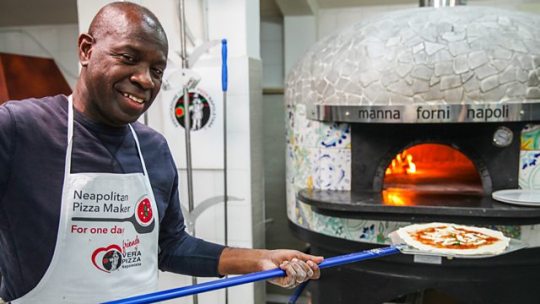
To prepare for our trip we watched Clive Myrie's good-humoured BBC series on Italy.
The episode on Naples, which aired just before we travelled, portrayed the city as a glorious melting pot brimming with history and conviviality, the home of pizza and the beating heart of the multicultural south.
Workshops in picturesque alleyways were "fast becoming one of the city's most exciting creative hubs", Myrie told us.
I'd also read Gomorrah by the investigative journalist Roberto Saviano, which depicts Naples and its region as a crime-ridden hellhole.
I kept those contrasting images vivid in my mind by calling the first Neapolis and the second Nablus (Naples and the impoverished West Bank city, both ancient Greek settlements, share a common etymology.)
Outside the airport terminal, we followed signs for the buses. I wasn't completely sold on that mode of transport: the Alibus website showed pictures of long lines of backpackers waiting to board under a hot sun, which did not bode well for the frequency of the service. On the other hand, the fare was cheap (€5) and as the night had fallen we were at little risk from sunstroke.
On our way to the bus stop, a man offered to drive us to the city centre, along with a few fellow tourists, for €5 each. Being accosted and directed towards a collective taxi was more evocative of Nablus than Neapolis, but we decided to take a chance.
The minivan was comfortable and delivered us to Piazza Garibaldi in 20 minutes. This was Neapolis after all. The driver even pointed the way towards our hotel.
Like most central squares in European cities, the Piazza Garibaldi features vast open spaces, far-reaching transport links and the statue of a national hero. But while similar urban foci across the Mediterranean world are usually alive with crowds in the evening, the piazza offered nothing but empty gloom.
The main road along the Centro Storico was not much more animated. A fast-food joint was open. A few shadows shuffled past. After 300m we turned into ramshackle lanes strewn with refuse: definitely Nablus.
I wondered if we might have got lost. How could such a slum attract tourists? But Google Maps does not lie: we found our hotel tucked away behind a metal door.
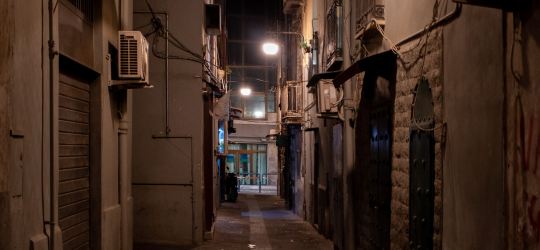
"Is there a place where we can eat around here?"
My tentative query was met by a confident response. "Pizzeria del Popolo: 300m away, just across Piazza Mercato," the young woman at the reception said.
The piazza in question would make a perfect location for a brutalist dystopia. Lined on one side by a housing block that shows every sign of having been built with what Roberto Saviano calls "Camorra cement", it is dominated by an installation shaped like a giant dog turd. Not a soul was stirring.
We found our restaurant, as discreetly positioned as our hotel, at the bottom of the housing block. Once inside, the atmosphere changed.
Maybe that's what happy families do in Naples in the evening: they go to the pizzeria instead of hanging out in squares. A 31st birthday was being celebrated at one table. It was vibrant and proper – none of the boozy ruckus such events occasion in Britain.
My only quibble was the lack of wine: real Neapolitans, it seems, wash down their food with beer. But they sure can do pizza here: unctuous dough and fresh ingredients for €8 - a ridiculously small price to pay for a taste of Neapolis in the middle of Nablus.
Previous entry on Naples:
. Ryanair
2 notes
·
View notes
Text
International Tennis of Italy at Piazza del Popolo- Rome
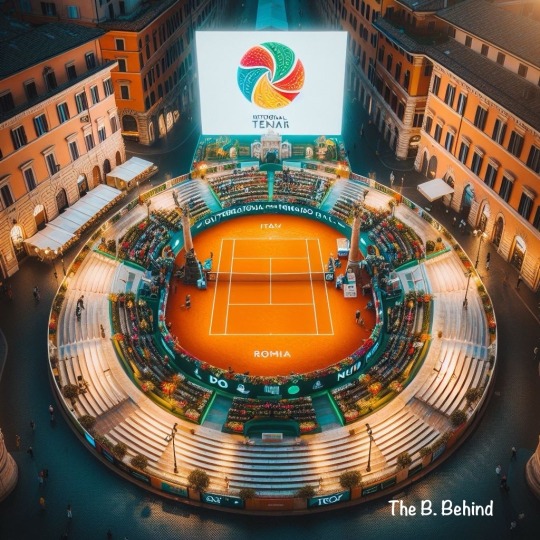
Once again, Rome makes history. International tennis of Italy at Piazza del Popolo 🎾❤️
Long live Rome. All the time.
📍 The international tennis of Italy is within everyone's reach at the Piazza del Popolo in Rome. 🎾🎾🎾🏐🏐🏸🏸🏸🏸🏓🏓🏓
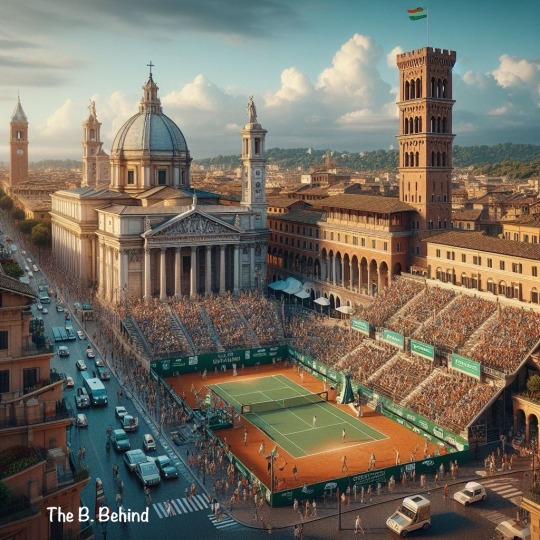
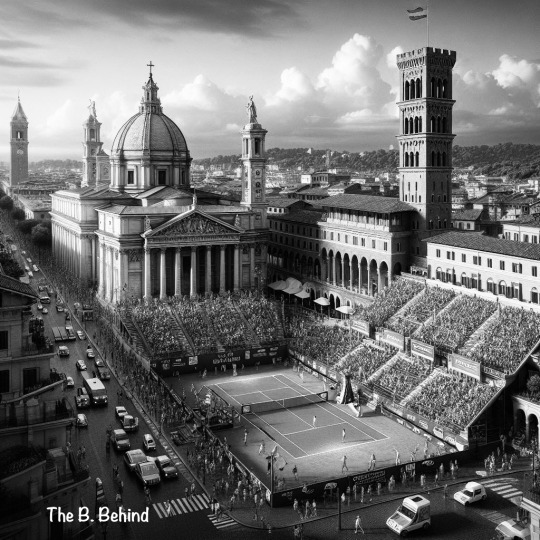

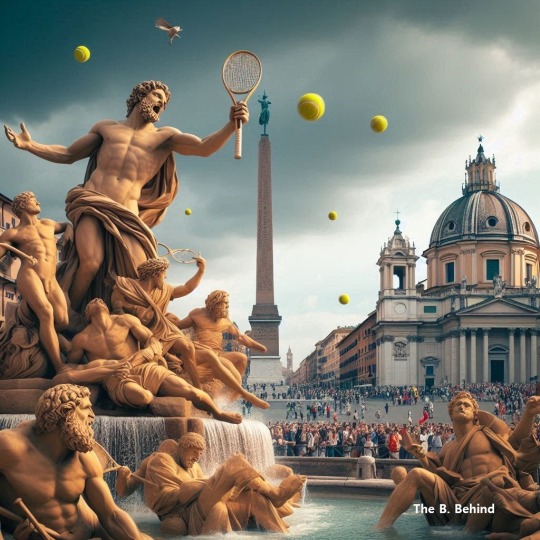
📍📍 Internazionale di Tennis d'Italia alla portata di tutti a Piazza del Popolo in Rome.🎾🎾🎾🏐🏐🏸🏸🏸🏸🏓🏓🏓
Tennis, the magic of the Internationals, comes to Piazza del Popolo.
The clay court, set up in the center of Rome, was inaugurated. Until May 4th, pre-qualifying will be held with two competitions a day, one for men and one for women.
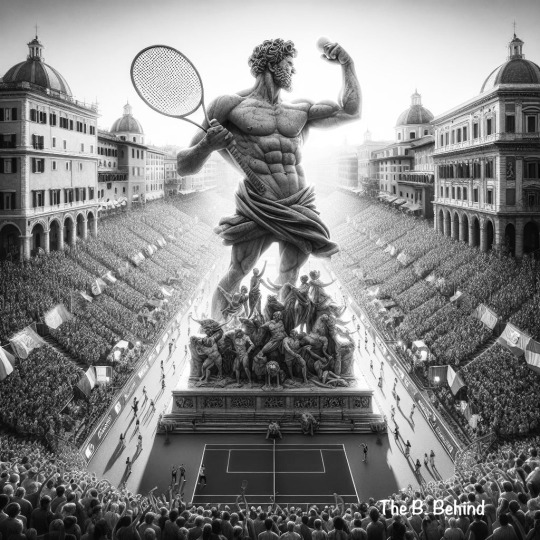
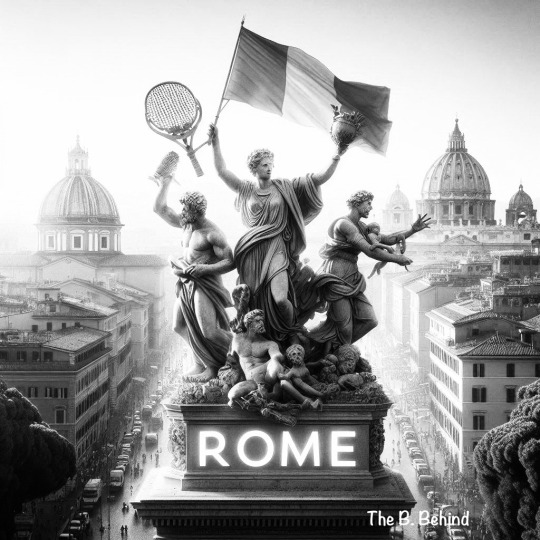
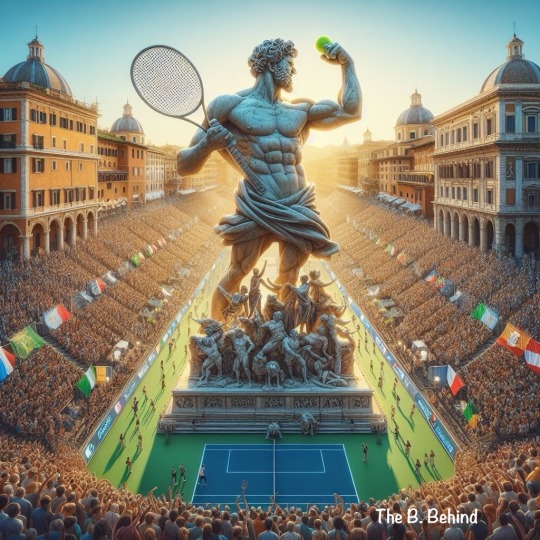

📍📍 From April 30th to May 4th, Thanks to a project sponsored by the Italian Tennis Federation and Padel —FITP— internationals will take to the streets to embrace the Roman people. Entrance is free.
.
✅ The Magic of Tennis in Rome: A Spectacle at Piazza del Popolo
There's a unique magic that fills the air when the Internationals come to Rome. The city, already rich with history and culture, becomes a vibrant hub for tennis enthusiasts from around the world. The heart of this excitement? Piazza del Popolo.
The Piazza del Popolo, a grand public square in Rome, transforms into a tennis lover's paradise. The cobblestone streets echo with the sounds of tennis balls bouncing and rackets swinging. The energy is palpable, the excitement, contagious.
Spectators gather, their eyes glued to the impromptu courts, their hearts beating in sync with each serve and volley. The players, some of the best in the world, display their skills under the Roman sky, adding to the city's enchantment.
The Internationals in Rome is not just a tennis tournament; it's a celebration of sport, camaraderie, and the eternal city itself. So, when the Internationals come to Piazza del Popolo, they bring more than just tennis; they bring a magic that's uniquely Rome.
🎾 Tennis, Rome, Internationals, Piazza del Popolo, Magic, Celebration.
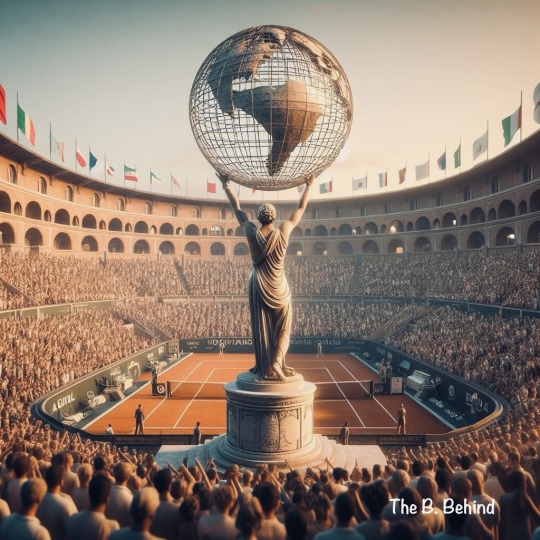
.
.
.
#the board behind#italy#theboardbehind#international tennis Italy#Piazza del Popolo Rome#Tennis for all#italian sports#rome tennis#FITP#federazione italiana tennis#Visit Lazio#Lazio tourism
0 notes
Text
Pesaro2024: la Capitale Italiana della Cultura accende il suo "Albero della Vita"

Pesaro2024: la Capitale Italiana della Cultura accende il suo "Albero della Vita".
Pesaro 2024 "accende" il suo "Albero della vita" con una cerimonia popolare che ha richiamato in piazza del Popolo migliaia tra pesaresi e 'cittadini temporanei' accorsi per assistere all'inaugurazione della Biosfera, installazione scultoreo-digitale unica in Europa con i suoi 4 metri di diametro e oltre 2 milioni di Led. Un'opera viva, interagibile e in dialogo con la città e la collettività, ideata per narrare e condividere La natura della cultura della Capitale italiana della cultura e "lanciare Pesaro nel futuro della modernità" ha detto Matteo Ricci, sindaco di Pesaro.
"L'idea della Biosfera nasce dall'esigenza di avere un simbolo di Pesaro 2024, un'icona che potesse incarnare e raccontare La natura della cultura della nostra Capitale: la sfida culturale e il rilancio della Pace, che camminano parallelamente a quella della sostenibilità" spiega il sindaco, che continua: "Ci siamo ispirati all''Albero della Vita" di Expo 2015, un simbolo di cui tutti abbiamo memoria, declinandolo con un oggetto iconico vicino a Pesaro: la sfera. Presente nella 'Palla' di Arnaldo Pomodoro, nella Sonosfera®️, nella Pizza Rossini, nella ruota della bici che percorre la Bicipolitana e in quelle delle moto della nostra Terra di Piloti e Motori, e nel sole che tramonta sul mare Adriatico.
La Biosfera è un'icona, un oggetto di design e di alta tecnologia, che ci renderà ancora più attrattivi e più competitivi. Ma allo stesso tempo che farà riflettere sul cambiamento climatico. Un progetto realizzato grazie al bando vinto dal Comune di Pesaro, tramite l'assessorato all'Innovazione guidato da Francesca Frenquellucci, della Casa delle Tecnologie Emergenti (CTE Square, finanziato dal Ministero delle Imprese e del Made in Italy, con 11milioni di euro) che comprende tra l'altro la realizzazione di progettualità tecnologiche di alto livello. Dentro la Biosfera troverete le unicità e le bellezze della nostra città e del pianeta, buona visione".
E ancora, "Quella di ieri è stata un'anteprima; in generale quella dell'accensione della Biosfera è la seconda grande cerimonia della Capitale italiana della cultura, dopo l'apertura del 20 di gennaio alla Vitrifrigo Arena con il presidente della Repubblica Mattarella.
Quel giorno è stato straordinario, perché abbiamo visto crescere l'entusiasmo e la partecipazione dei pesaresi, con una copertura mediatica nazionale ed internazionale unica. Avevamo detto che sarebbe stato solo l'inizio, e così è: in queste settimane il programma ha cominciato a prendere forma, con tante iniziative culturali e artistiche che proseguiranno a ritmi intensi nei prossimi giorni (il 29 febbraio, nel compleanno di Rossini, l'inaugurazione dell'Auditorium Scavolini; l'1 marzo la cerimonia della cittadinanza a Francesco "Pecco" Bagnaia, ndr). Grazie anche alle forze dell'ordine, alla Protezione civile, alla Polizia locale, ai VolontarX e al team di Pesaro 2024".
La Biosfera sarà luogo di aggregazione, promozione culturale e tecnologica tramite gli interventi audiovisivi che attraverseranno i suoi milioni di Led e che combineranno arte e scienza, patrimonio culturale e tecnologia, storia e innovazione.
"È un progetto simbolo della Capitale - sottolinea Daniele Vimini, vicesindaco assessore alla Bellezza -, sintesi perfetta tra tecnologia, patrimonio e sostenibilità, alla base di ciascuno dei progetti di dossier di Pesaro 2024. La presenterà il patrimonio del territorio e contenuti interattivi inediti e interagenti con il pubblico che si muoverà attorno all'opera. Sarà inoltre collegata all'attualità, in particolare al tema dei cambiamenti climatici. Sarà un modo per collegarsi al mondo, per collegare il mondo a Pesaro e farne un punto di ritrovo per i pesaresi e per i 'cittadini temporanei' che ci raggiungeranno per la Capitale e che crediamo si affezioneranno anche alla versatilità di questo strumento capace di ribaltare il paradigma dell'oggetto tecnologico solo per specialisti".
La Biosfera è infatti "per tutti – continua Vimini - e, allo stesso tempo, permette di innalzare la caratura tecnologica e artistica di Pesaro 2024; potrà interagire con artisti, designer, musicisti ai quali rivolgeremo un concorso internazionale per la creazione di contenuti – sulla linea di quanto già attivato per la Sonosfera® (ISAC – International Sonosfera® Ambisonics Competition, promosso dal Comune di Pesaro in collaborazione con IRCAM – Centre Pompidou di Parigi) – che qualificheranno e arricchiranno il palinsesto della Biosfera e di Pesaro 2024".
L'installazione è frutto della convergenza di mezzi digitali, avanzate tecnologie e ricerche artistiche; è un patrimonio della città, un elemento artistico, una struttura innovativa che genera contenuti e votato alla ricerca e allo sviluppo di tecnologie pensate per potenziare l'engagement e il turismo. È l'elemento di sintesi de La natura della cultura della Capitale. "Ed è anche frutto di una condivisione su cui l'Amministrazione ha investito e che ha permesso di usare il know how esistente, potenziarlo e destinarlo al territorio, tramite 'CTE Square', la Casa delle tecnologie emergenti, progetto che si pone l'obiettivo di fertilizzare le aziende del territorio di Pesaro 2024, spingerle a realizzare nuovi prodotti e servizi per innalzarne il posizionamento nei settori della cultura, del turismo e dell'engagement" ha spiegato l'assessora all'Innovazione e Partecipazione Francesca Frenquellucci.
A progettare l'installazione sono stati da Federico Rossi (professore associato in architettura digitale alla London South Bank University) e Andrea Santicchia (artista transdisciplinare e docente presso il corso di Interaction Design at IUAV) di Artifact Studio.
I CONTENUTI
L'installazione è spazio in cui far convergere e disporre un dialogo multidisciplinare ospitando opere di natura artistica e scientifica.
La prima opera è Pesaro 2024, che punta alla valorizzazione del territorio e della cultura della città. Sulla superficie sferica vengono visualizzati video a 360 gradi del patrimonio paesaggistico, storico, artistico-culturale del territorio. Una reale immersione che permette di ripercorrere i luoghi della Capitale con una modalità inedita. Stravolgendo la percezione canonica, la visione sferica, apre a una dimensione tridimensionale e fa immergere il pubblico in una esperienza dello spazio a metà tra mondo reale e digitale.
La seconda opera, Data Visualization Climate Change, trasforma dati e algoritmi da entità astratte in visualizzazioni e simulazioni che stimolano una riflessione sulla relazione tra uomo e pianeta mettendo in connessione natura, scienza e tecnologia.
La matrice sono i dati raccolti sullo stato di salute del pianeta Terra attraverso i satelliti del progetto Copernicus dell'Unione Europea, coordinato da ESA, utilizzati come nuovo alfabeto per creare un corpus di visualizzazioni che guida gli spettatori a una nuova comprensione e consapevolezza sul cambiamento climatico. I dati si materializzeranno in composizioni estetiche.
Il dialogo tra dati scientifici e design generativo crea, attraverso l'intelligenza artificiale e complessi sistemi algoritmici, simulazioni che stimolano a una riflessione visiva ed esperienziale sul cambiamento climatico.
La terza opera, Materia, è una scultura digitale all'interno della struttura-sfera modellata in real-time dal movimento degli spettatori attorno a essa. La Biosfera è involucro, guscio che contiene una materia digitale-plastica multiforme che si fessura, faglia e plasma. L'opera è una scultura generativa, condivisa e collettiva, nata dall'interazione con gli spettatori. All'interno si creano geometrie tridimensionali magmatiche in evoluzione, rese interattive dalla posizione nello spazio del pubblico. Come "natura tecnologica" soggetta all'erosione, le forme si scavano e sono rese malleabili dall'influsso umano. L'opera interroga il binomio uomo-natura, l'influsso umano sulla materia e le potenzialità di creazione e distruzione. È metafora dell'influsso dell'umanità sui fragili ecosistemi.
Durante l'anno della Capitale previsti interventi site-specific; contenuti artistici, musicali o scientifici all'interno della sfera scaturiti da collaborazioni con artisti, musicisti, designer, ricercatori, scuole e altri enti.
Le accensioni della Biosfera sono in programma, ogni giorno con i tre contenuti, della durata complessiva di circa 20 minuti, alle ore 10, 12, 16, 18, 20, 22.
L'azienda fornitrice del servizio energia, in accordo con Pesaro 2024, si impegna a produrre la stessa quantità utilizzata dalla Biosfera, da fonti rinnovabili - acqua, vento, sole, calore della terra e biomasse - e ri-immetterle nella rete.
Pesaro 2024 - Capitale italiana della cultura è possibile grazie a:
Partner istituzionali: Comune di Pesaro, UNESCO, Ministero della cultura, Regione Marche.
Con il sostegno di: Camera di Commercio delle Marche, Fondazione Cassa di Risparmio di Pesaro, CTE Square - Casa delle Tecnologie Emergenti.
Main partner: Gruppo Hera, Scavolini, Intesa Sanpaolo.
Gold partner: TeamSystem, Enel, Amplia, Freetox.
Partner: Lindbergh Hotels & Resorts, Fox Petroli, Renco, Alpitour World, Fileni, Si con te, Lancia Impresa Edile.
Sostenitori: Benelli Moto, Ratti, Coop Alleanza 3.0, Felici Costruzioni e Restauri.
Food partner: Food Brand Marche.
'50x50 Capitali al quadrato' Special Partner '': Banca di Pesaro – Credito Cooperativo
Technical partner: Maggioli Cultura e Turismo, Fondazione Wanda di Ferdinando, APA Hotels.
Con il contributo di: Confartigianato Imprese Ancona - Pesaro e Urbino, Confcommercio Pesaro e Urbino/Marche Nord, Confindustria Pesaro Urbino, CNA, Fondazione Cassa di Risparmio di Fano.
Official airport: Ancona International Airport.
Media partner: Ansa, QN - Quotidiano Nazionale – Il Resto del Carlino, RAI.
Official radio: Rai Radio2....
#notizie #news #breakingnews #cronaca #politica #eventi #sport #moda
Read the full article
0 notes
Text
Assignment #9 Rome Exploration Projects Appendix E
Any five of the 13 Obelisks
Describe their setting and provide information of where each one came from, who brought it here, and when it was placed where it is now. Take a photo for your blog. Draw a map (just a rough hand drawing) orienting them to each other and a few landmarks (monuments, hotel, bars, etc.). Use this map to mark your exploration around the city.

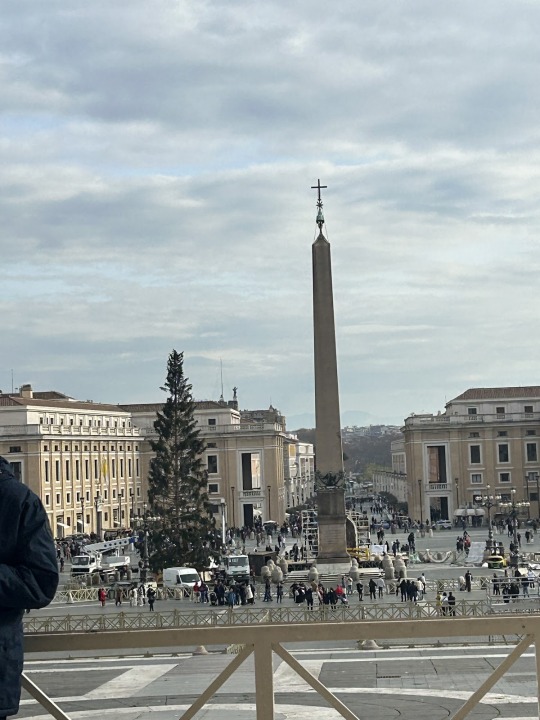

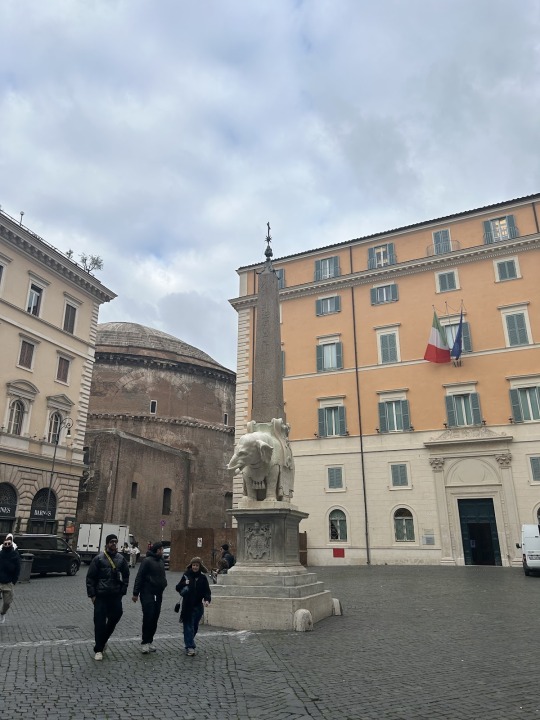
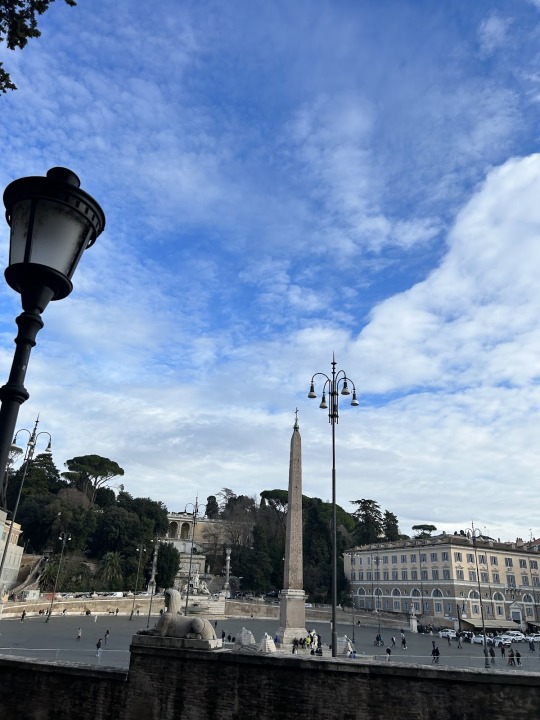
Piazza della Rotonda: Origin: Egypt @1400BC Found in 1575, this is from the Temple of Isis
St. Peter’s Square: Origin: Egypt, 100BC Raised in the 1500s.
Piazza di Monte Citorio: Origin: Egypt, 700BC This obelisk also functions as a sundial. Brought to Rome by Emperor Augustus.
Piazza della Minerva: Origin: Egypt, @500BC The elephant is sculpted by Bernini. It is from the Temple of Isis.
Piazza del Popolo: Origin: Egypt, 1400BC Brought by Emperor Augustus and put in the Piazza in the 16th century.
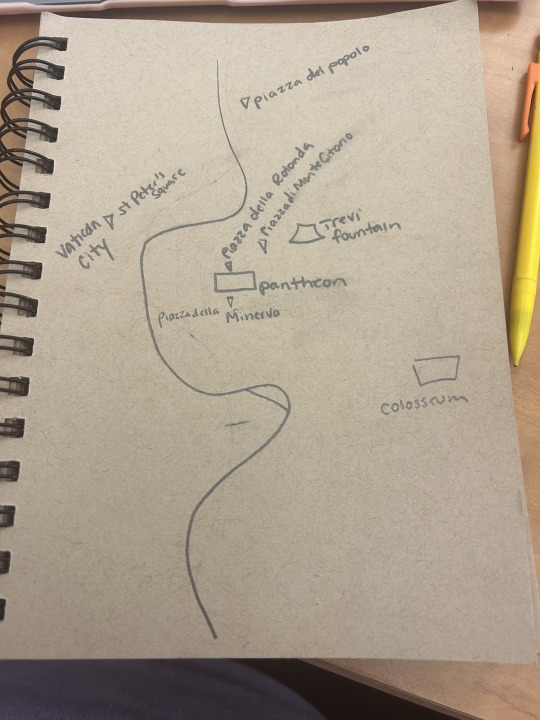
Santa Maria Sopra Minerva
It was named after the Greco Roman Goddess Minerva. Sopra meaning “above” because it’s built on top of a ruined temple of Minerva. Michelangelo's Cristo della Minerva.
Pantheon
How many ‘steps’ tall is the oculus of the dome?
71.14 meters tall
Trajan’s Column
How many times does the frieze circle the column? 25 times.
Caravaggio
Find and photograph any ten Caravaggio paintings in Rome:
Briefly describe the content of each paintings. Also, what is the most brightly painted object in each of the paintings? Use one (or more) of the Caravaggio paintings that you discovered in Rome to respond to Michael Fried’s account of absorption (in the Soundcloud lecture). Set out Fried’s account and then how the painting does or does not fit his account. Write 500 words.

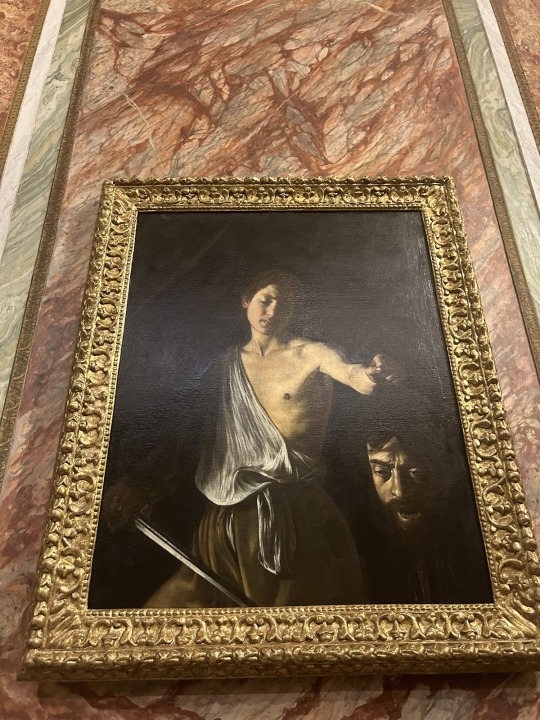
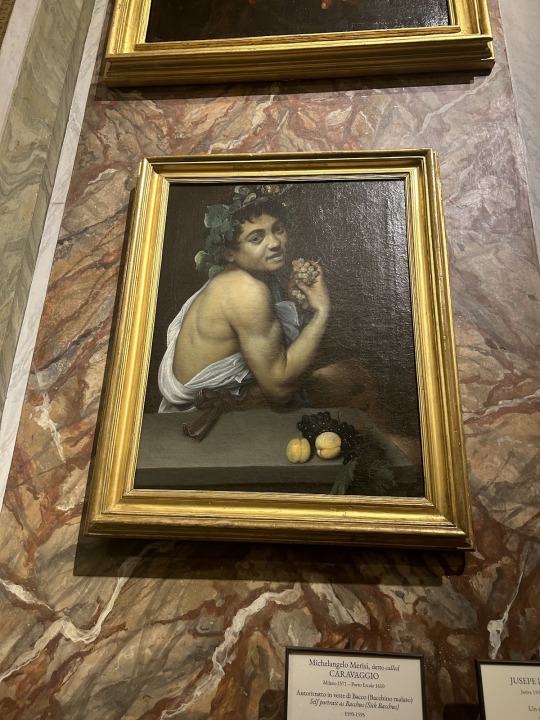
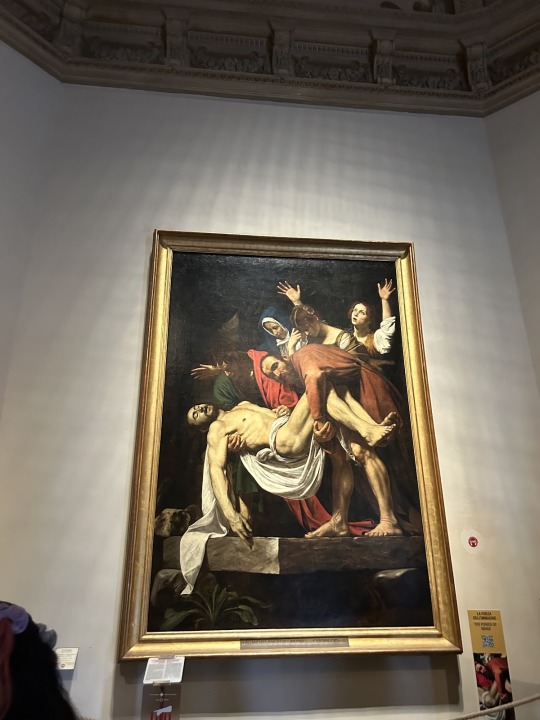
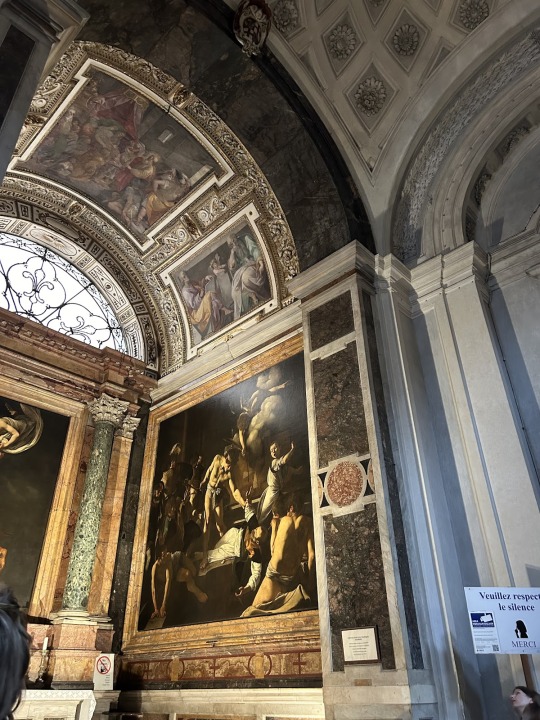
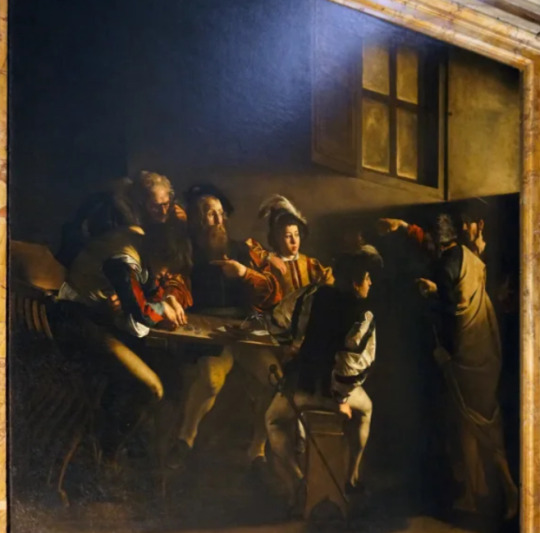

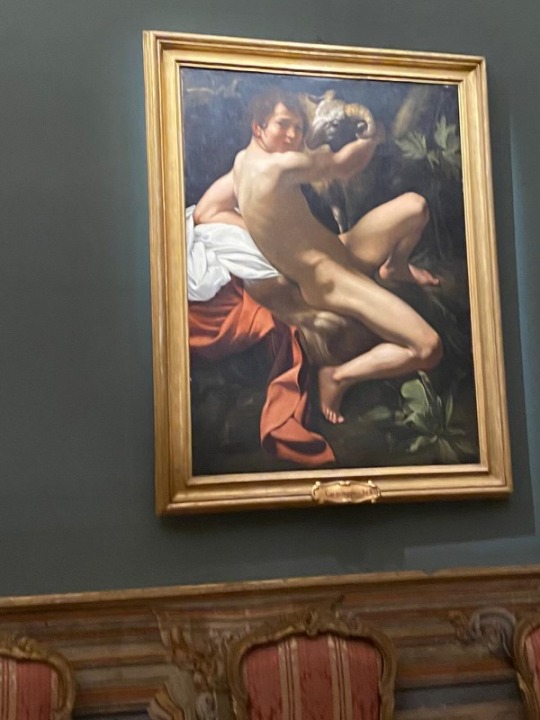

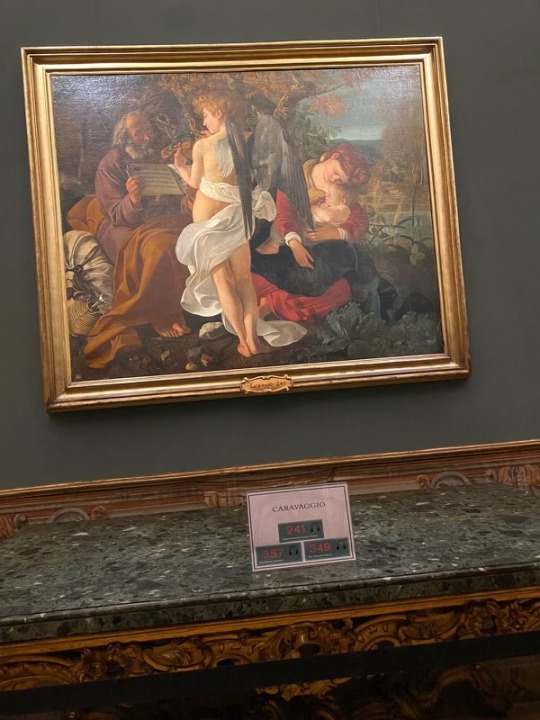
Madonna Dei Palafrenieri
There are three people pictured, two women and a child. The two women have halos and the child is naked and focusing his attention onto a snake. It is the Virgin Mary, baby Jesus, and St Anne. The brightest thing appears to be the Virgin Mary and Jesus as St Anne appears to have darker hues as if she’s in the shadows a little bit. The nudity of baby Christ stands out because his pale skin is pictured against a dark background.
David with the Head of Goliath
David stands holding the severed head of Goliath. David is younger and more youthful in appearance, but is not as young as other depictions of him. He is looking almost, distastefully at the head of Goliath. The brightest thing would be either David himself or the sword he is holding.
Young Sick Bacchus
This is a self portrait as Bacchus holding grapes and you can see in the painting that he appears to be ill of some sort. He is wearing a wreath on his head and there is fruit on the table. Most of the colors used here are muted. The brightest thing is either him, or the peaches pictured but the peaches only appear to be brighter as they as set next to dark grapes.
The Entombment of Christ
There are six people pictured in the Entombment of Christ. The focus on the painting is on a deceased Christ. The colors he uses draws your eyes to Christ’s body as he is pale and in white against a dark background.
The Martyrdom of St Matthew
There are several figures in the Martyrdom of St Matthew. It’s got a hectic feel with people all over the place in different positions. The eyes draw to the center as well as the two figures in the middle because there is more light shining on them and the rest of the figures are in the shadows.
The Calling of St Matthew
This painting depicts the conversion and awakening of Saint Matthew by Jesus Christ himself. Jesus and Saint Peter are pointing to him as if to call for him at this table of men. The light seems to be coming from the direction that Jesus and Saint Peter came from and it is illuminating the faces of the men at the table.
Inspiration of St Matthew
There are two figures in the image, Saint Matthew and an Angel. The angel came to him as he was working. The more illuminated figure would be Saint Matthew as the angel is partially in the shadows, but not by much to be mentioned.
John the Baptist
There are two figures in this painting and it is John the Baptist and a ram. John is in his youth in nudity and has one of his arms around the ram. The light shines on both the figures, but they are not fully illuminated.
Penitent Magdalene
There is only one figure in this painting of a young woman. This color palette stands out to be as being brighter than most of his paintings that I have observed so far. Her gaze is downwards into her lap and she is crying. She is the brightest thing in this photo.
Rest on the Flight into Egypt
There are two people, a baby, and an angel pictured in this painting. Joseph and Mary are caring for an infant Jesus as the angel plays music for them. Joseph is almost in the shadows and the light appears to be mostly on the Angel, Mary, and Jesus.
I think that Michael Fried’s account of absorption does fit Caravaggio’s paintings. Especially in “The Martyrdom of Saint Matthew.” According to Fried, absorption describes how the figures in his paintings are absorbed within themselves. They are full of introspection and present reality. It gives a sense of presentness. The background and composition of his paintings convey absorption well.
In “The Martyrdom of Saint Matthew” the figures portray absorption. They do this by reacting within the moment of time that they are in. It is shown in this composition because everyone is staring at the same thing, the figures in the middle. It is not only the direction of their heads, but also their facial reactions that portray absorption. His expressions make it unmistakable to understand what is happening in the moment. There are levels of shock, and horror upon their faces to examine. The painting depicts the martyrdom of Saint Matthew. He has fallen by the hand of his executioner who has stabbed him with a rapier and just above him is an angel reaching down. The angel reaches down, but only Matthew can see him. Matthew’s arm is trying to reach the angel. Nobody else is focused on the area the angel is located. This is a spiritual connection that is happening exclusively for Matthew as he is being martyred.
Caravaggio also adds onto the absorption through his work of light and where it falls and who it illuminates. Fried also mentions that Caravaggio’s use of doubling/mirrors adds onto the idea of absorption. It is the doubling of figures and mirrored images that further the concept of introspection. The use of mirrored images comes into play with David and Goliath and Sick Bacchus as those are self portraits of Caravaggio’s. He uses his own face to be able to convey a sense of inwardness and depth of feeling he may not be able to get with a model. The sense of inwardness and depth add onto the immersion of the subjects of the paintings.
The absorption in David and Goliath is quite clear. There are only two faces to analyze and one of them is deceased. David’s face, and in the literal sense, Caravaggio’s face the one and the same, conveys a sense of pensiveness and sadness. The background is dark so there is nothing to focus on, except David with the head of Goliath. The use of light shows that in this moment he is preoccupied with Goliath’s head and the reality of what it means to have beheaded him in battle. By using a dark background Caravaggio was able to portray absorption through their faces and the light. The picture is after victory and the moment portrayed is the thought after action.
Michelangelo’s Moses: briefly compare Freud’s account of the Acropolis to his account of Michelangelo’s Moses. Pictures of both.
They both grip him very powerfully in ways he cannot fully fathom and describe. The Acropolis was a surreal experience for him and as for Moses he thinks it is inscrutable.
Borghese
Find statue of a woman in peplos.
When was it made ?
Arte Romana 3rd Century AD
Caravaggio and Bernini. Both made David’s; how do they compare?
Bernini depicts David the moment before killing Goliath whereas Caravaggio depicts him in the moments after Goliath’s beheading. Bernini’s David appears older, the reason for this I’m unsure, but the age of Caravaggio’s David is because it is a self portrait of him holding an older version of himself’s head. It’s difficult to compare sculpture to painting, but I would say Caravaggio’s is more gory.
Bernini Aeneas, Anchises and Ascanius -- what does Aeneas carry?
He carries his father.
Roman Hermaphrodite. How does it compare to the Canova in DC?
They used different supportive positions. Canova’s is “less modest” in a way in relation to its nudity.
0 notes
Text
youtube
Ravenna Romagna Italy - City Drone view cinematic films video 2024
Ravenna Romagna Italy - City Drone view cinematic films video 2024.#italy Ravenna is a historical city in the Emilia-Romagna region of Italy, known for its rich cultural and artistic heritage. Famous for its well-preserved Byzantine mosaics, Ravenna boasts eight UNESCO World Heritage sites, including iconic landmarks like the Basilica di San Vitale and the Mausoleum of Galla Placidia. The city's history dates back to Roman times, and it served as the capital of the Western Roman Empire in the 5th century. Today, Ravenna attracts visitors with its unique blend of history, architecture, and artistic treasures.
Please subscribe to my channel:@DMmahfuz14318
The drone hovers over Romagna, Italy, revealing a tapestry of terracotta rooftops against the backdrop of rolling hills. The vibrant hues of the Adriatic Sea glisten on the horizon. Narrow cobblestone streets wind through medieval architecture, leading to bustling market squares. Vineyards and olive groves carpet the landscape, showcasing the region's rich agricultural heritage.
The imposing structures of ancient churches and castles stand as testaments to Romagna's storied history. From above, the mosaic of colors in local markets and the aromas of Italian cuisine waft through the air. The drone captures the essence of daily life, with locals engaging in lively conversations at sidewalk cafes. The city's landmarks, like the Arch of Augustus, stand proudly, narrating tales of the past.
Sunlight dances on the canals, reflecting the charm of Romagna's waterways. This aerial perspective highlights the fusion of tradition and modernity in the cityscape, with contemporary buildings interspersed among historic ones. The drone reveals the Adriatic Riviera's pristine beaches, inviting visitors to bask in the sun. As the camera pans, glimpses of cultural festivals and lively events unfold, showcasing the vibrant community spirit.
The vibrant street art and murals add a modern flair to the timeless surroundings. The intricate network of alleyways invites exploration, unveiling hidden gems and local craftsmanship. Romagna's lush parks and green spaces provide a tranquil escape from the urban hustle. The drone captures the rhythm of daily life, from bustling markets to leisurely strolls along the city walls.
At night, the city transforms into a twinkling panorama, with city lights reflecting on the water, creating a mesmerizing nocturnal spectacle. The timeless beauty of Romagna unfolds in this breathtaking drone view, encapsulating the spirit of this enchanting Italian city.
Ravenna is my hometown, it has about 150,000 inhabitants and it's a place very rich in history and has a truly remarkable past. Ravenna has in fact 8 Unesco monuments and despite being a small town, it is double the number of Unesco monuments existing in London.
In the video I shot, you will see several, from San Vitale to Sant'Apollinare Nuovo, the Mausoleum of Theodoric, Sant'Apollinare in Classe, the Mausoleum of Galla Placidia, passing through other important sites such as the Duomo, the Dante area, Piazza del Popolo and the historic center, the Basilica of San Francesco reserving a look also at the Darsena di Città (docks), the localities of Marina di Ravenna with its beaches and Classe with its pine forest.
#ravenna romagna italy city drone view cinematic films video 2024#ravenna romagna italy city drone view#ravenna italy city view 2024#ravenna#Youtube
0 notes
Link
0 notes
Text
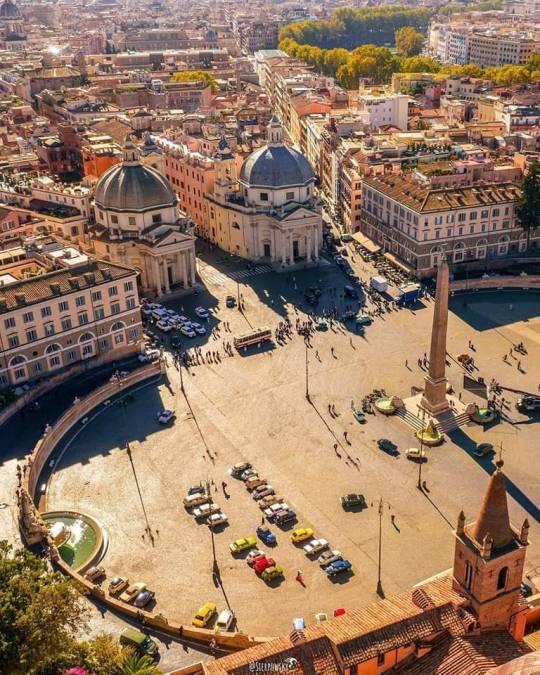
PIAZZA DEL POPOLO - ROMA
75 notes
·
View notes
Text
Italian left-wing parties protest against Meloni’s government
Italy’s left-wing parties took to the streets of Rome to protest the government of Prime Minister Giorgia Meloni.
Members of Elly Schlein’s Democratic Party and former Prime Minister Giuseppe Conte’s 5-Star Movement gathered in Piazza del Popolo to participate in the protest. In their speeches, Ely Schlein, Giuseppe Conte, Angelo Bonelli of the Greens and Nicola Fratoianni of Sinistra Italiana called for unity as an alternative to the ruling right.
“There is an alternative (…) A new phase begins here. The left must be rebuilt (…), but political convergence and a united spirit are also needed. This is the square of rediscovered pride.”
Despite the dialogue on the left front, the former prime minister stressed his commitment to the idea of the “right camp.”
I am for the ‘right camp’ and not the ‘wide camp’. We are here to confirm the dialogue that has already begun with PD (…) we are autonomous forces, and dialogue serves to converge and mark differences.
Read more HERE
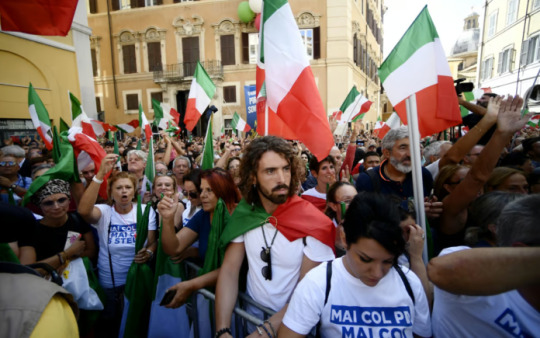
#world news#world politics#news#europe#european news#european union#eu politics#eu news#italy news#italy 2023#left wing#protest#protests#meloni#georgia meloni
0 notes
Text
Because even after the PD square, the wide field is an uphill road
The day after the demonstration in Piazza del Popolo, the secretary of the Democratic Party can breathe a sigh of relief. It went well, the square was full, no controversial incidents to tarnish the initiative. Even beyond predictions, because that “dear Elly” from Giorgia Meloni, that unexpected response quickly via social media, as if she were in front of the TV keeping an eye on her opponent,…
View On WordPress
0 notes
Text
Despite the west numerous and never ending efforts to destroy it,the PRC stands strong in defiance of ghe west and nato!
The post is machine translated
Translation is at the bottom
The collective is on telegram
😍 Compagni, amici di Collettivo Shaoshan - oggi, 1 ottobre, si celebra il 74° Anniversario della Fondazione della Repubblica Popolare Cinese 🇨🇳
🇨🇳 La Bandiera Nazionale della Repubblica Popolare Cinese è stata scortata in Piazza Tiān'ānmén da 96 Membri della Guardia d'Onore dell'Esercito Popolare di Liberazione, e poi è stata issata 🚩
💬 «La Fondazione della Repubblica Popolare Cinese ha reso il Popolo Cinese il vero padrone del Paese, della Società e del proprio Destino. Ha realizzato il grande balzo della Cina verso il Sistema della Democrazia del Popolo, raggiungendo un elevato grado di unità senza precedenti nella Storia della Cina, ponendo fine alla società semi-coloniale e semi-feudale» | Xi Jinping ⭐️
🌸 Iscriviti 👉 @collettivoshaoshan 😘
😍 Comrades, friends of Shaoshan Collective - today, October 1, we celebrate the 74th Anniversary of the Foundation of the People's Republic of China 🇨🇳
🇨🇳 The National Flag of the People's Republic of China was escorted to Tiān'ānmén Square by 96 Members of the People's Liberation Army Honor Guard, and then hoisted 🚩
💬 «The Foundation of the People's Republic of China has made the Chinese People the true masters of the country, of society and of their own destiny. It achieved China's great leap towards the People's Democracy System, achieving a high degree of unity unprecedented in the history of China, putting an end to the semi-colonial and semi-feudal society» | Xi Jinping ⭐️
🌸 Subscribe 👉 @collectivoshaoshan 😘
#socialism#china#italian#translated#collettivoshaoshan#china news#communism#marxism leninism#marxist leninist#marxist#marxismo#marxism#chinese communist party#communist party of china#anti imperialist#anti imperialism#people liberation army#people's republic of china#anniversary
0 notes